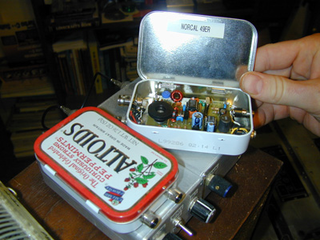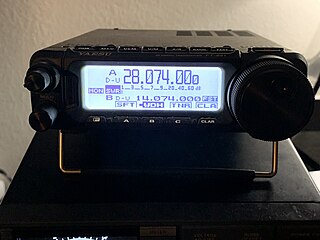
In amateur radio, QRP operation refers to transmitting at reduced power while attempting to maximize one's effective range. QRP operation is a specialized pursuit within the hobby that was first popularized in the early 1920s. QRP operators limit their transmitted RF output power to 5 W or less regardless of mode.

Software-defined radio (SDR) is a radio communication system where components that conventionally have been implemented in analog hardware are instead implemented by means of software on a computer or embedded system. While the concept of SDR is not new, the rapidly evolving capabilities of digital electronics render practical many processes which were once only theoretically possible.
An antenna tuner, a matchbox, transmatch, antenna tuning unit (ATU), antenna coupler, or feedline coupler is a device connected between a radio transmitter or receiver and its antenna to improve power transfer between them by matching the impedance of the radio to the antenna's feedline. Antenna tuners are particularly important for use with transmitters. Transmitters feed power into a resistive load, very often 50 ohms, for which the transmitter is optimally designed for power output, efficiency, and low distortion. If the load seen by the transmitter departs from this design value due to improper tuning of the antenna/feedline combination the power output will change, distortion may occur and the transmitter may overheat.
160-meter band refers to the band of radio frequencies between 1.8 and 2 MHz, just above the medium wave broadcast band. For many decades the lowest radio frequency band allocated for use by amateur radio, before the adoption, at the beginning of the 21st century in most countries, of the 630- and 2200-meter bands. Amateur operators often refer to 160 meters as the Top Band It is also sometimes nicknamed the "Gentleman's Band" in contrast to the often-freewheeling activity in the 80-, 40- and 20-meter bands.

An S meter is an indicator often provided on communications receivers, such as amateur radio or shortwave broadcast receivers. The scale markings are derived from a system of reporting signal strength from S1 to S9 as part of the R-S-T system. The term S unit refers to the amount of signal strength required to move an S meter indication from one marking to the next.

Contesting is a competitive activity pursued by amateur radio operators. In a contest, an amateur radio station, which may be operated by an individual or a team, seeks to contact as many other amateur radio stations as possible in a given period of time and exchange information. Rules for each competition define the amateur radio bands, the mode of communication that may be used, and the kind of information that must be exchanged. The contacts made during the contest contribute to a score by which stations are ranked. Contest sponsors publish the results in magazines and on web sites.
The R. L. Drake Company is a manufacturer of electronic communications equipment located in Springboro, Ohio. It is also known for its line of equipment for amateur radio and shortwave listening, built in the 1950s through the 1980s. The company operates as a separate entity owned by Blonder Tongue Laboratories, Inc.

An amateur radio station is a radio station designed to provide radiocommunications in the amateur radio service for an amateur radio operator. Radio amateurs build and operate several types of amateur radio stations, including fixed ground stations, mobile stations, space stations, and temporary field stations. A slang term often used for an amateur station's location is the shack, named after the small enclosures added to the upperworks of naval ships to hold early radio equipment and batteries.

Yaesu FT-101 is a model line of modular amateur radio transceivers, built by the Yaesu Corporation in Japan during the 1970s and 1980s. FT-101 is a set that combines a solid state transmitter, receiver and a tube final amplifier. Its solid state features offer high-performance, low-current characteristics and its tube amplifier provides an almost mismatch-resistant transmitter and tuner stage. FT-101s were made with plug-in circuit boards that could be sent to the dealer or factory for replacement or repair. Until then, modular design was unprecedented in the amateur community. This also explains the fact why so many FT-101s are still in use today. The rig was sold worldwide as Yaesu FT-101 and in Europe as Yaesu FT-101 and as Sommerkamp FT-277. Because of its reliability it earned its nickname "the workhorse".

MFJ Enterprises, founded in 1972 by Martin F. Jue, is a manufacturer of a broad range of products for the amateur radio market. They specialize in station accessories, such as antenna tuners and antenna switching equipment. As of 2014, MFJ was responsible for manufacturing more amateur radio products than any other company in the world.

Vintage amateur radio is a subset of amateur radio hobby where enthusiasts collect, restore, preserve, build, and operate amateur radio equipment from bygone years, such as those using vacuum tube technology. Popular modes of operation include speaking over amplitude modulation (AM), and communicating using Morse code through continuous wave (CW) radiotelegraphy. Some enthusiasts have interest in owning, restoring and operating vintage military and commercial radio equipment such as those from 1940s to 1960s. Some undertake to construct their own gear, known in ham slang as homebrewing, using vintage parts and designs. A number of amateur radio clubs and organizations sponsor contests, events, and swap meets that cater to this specialized aspect of the hobby.
Homebrew is an amateur radio slang term for home-built, noncommercial radio equipment. Design and construction of equipment from first principles is valued by amateur radio hobbyists, known as "hams", for educational value, and to allow experimentation and development of techniques or levels of performance not readily available as commercial products. Some items can be home-brewed at similar or lower cost than purchased equivalents.
The Yaesu FT-77 is a transceiver to be used in the 3,5 – 29,9 MHz shortwave radio amateur segment. This means the coverage of the 80-40-30-20-15-17-12 and 10 meter HF bands.
The Yaesu VX series is a line of two sequences of compact amateur radio handheld transceivers produced by Yaesu. There is a line of ultra-compact lower-power dual-band transceivers that started with the VX-1R and was later updated with the VX-2R and VX-3R. There is also a line of 5 W tri-band transceivers that started with the VX-5R and was later updated with the VX-6R, VX-7R and VX-8R.

The G5RV antenna is a dipole with a symmetric resonant feeder line, which serves as impedance matcher for a 50 Ω coax cable to the transceiver.

The Yaesu FT-891 is a HF and 6 meters all mode mobile amateur radio transceiver. The FT-891 was first announced to the public by Yaesu at the 2016 Dayton Hamvention. The radio has 100 watts output on CW, SSB, and FM modulations and 25 watts of output in AM. As a mobile transceiver the FT-891 is well suited for mobile installation in vehicles, and weighing less than 5 pounds it is often used for field activations such as Summits On The Air and Parks On The Air. The radio has been praised for its noise reduction and sensitive receiver. Common criticisms of the radio include its many menus that are difficult to navigate with its small screen, the lack of VHF/UHF capabilities, and lack of an internal antenna tuner. Although the radio lacks an internal sound card it still has input and output jacks for audio and be controlled over a USB cable allowing the radio to use digital modes such as WinLink, PSK31 and FT8.

The ICOM IC-705 is a multimode HF/VHF/UHF portable amateur radio transceiver. The radio has 5 watts of output when using its internal battery and 10 watts of output when using external power. With the rise in award programs such as Summits on the Air, and Parks on the Air this lightweight fully functional radio is a popular choice for people using them in the field. The IC-705 has support for a wide variety of commonly used amateur radio modes including ICOM's proprietary digital voice mode D-STAR. The IC-705 is also one of the first mainstream amateur radios to use SDR technology instead of the older superheterodyne design. Additionally the IC-705 has multiple extra features that are useful when operating in the field. Supporting the radio's D-STAR module is a GPS receiver to allow users to send their location though the D-STAR network as well as help locate nearby repeater systems. In addition to the GPS receiver the radio supports 2.4 GHz Wi-Fi which allows users to connect their computers or tablets to the IC-705 for running digital data modes such as PSK31, Winlink, and FT8. The radio has been praised for its size, easy to use menus, large easy to read screen and the quality of its build. Common criticisms of the radio include its lack of a built in antenna tuner and its price compared to other more powerful radios on the market.

The ICOM IC-7300 is a multimode 6 meter, 4 meter and HF base station amateur radio transceiver. The IC-7300 was announced to the public at the Japan Ham Fair in 2015. The radio has 100 watts output on CW, SSB, and FM modulations and 25 watts of output in AM. Although not the first software-defined radio on the market, the IC-7300 was the first mass-produced mainstream amateur radio to use technology instead of the older superheterodyne transceiver design. Designed to replace the older IC-746PRO the IC-7300 is smaller and significantly lighter than its predecessor. Like many other radios of its class the IC-7300 has an internal antenna tuner and contains an internal audio card accessible over USB. This allows the radio to be used for popular digital modes such as PSK31, Winlink, and FT8. The radio has received praise for its easy to use menus, large readable screen, and excellent audio processing.
The ICOM IC-7100 is a multimode HF/VHF/UHF mobile amateur radio transceiver. The IC-7100 has support for a wide variety of commonly used amateur radio modes including ICOMs proprietary digital voice mode DSTAR. Additionally the radio offers 100 watts on HF, 50 watts on VHF, and 35 watts on UHF. The IC-7100 is unique in that it has a large detachable control head with a slanted display so the transmitter can be installed elsewhere in a vehicle or home. The receiver used in the IC-7100 is a triple conversion superheterodyne and has excellent DSP and audio filters. The IC-7100 allows for connection to a computer over USB which enables the radio to be used for popular digital modes such as FT8, Winlink, and Packet Operation. Locations of nearby repeaters and sending APRS locations can be done with an optional GPS receiver attachment. Notable features that the IC-7100 lacks is an internal antenna tuner.















